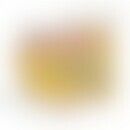Synonym(s)
DefinitionThis section has been translated automatically.
Nitroimidazole derivative, chemotherapeutic agent. Metronidazole is one of the most commonly prescribed agents. It is exceptionally well tolerated when applied topically.
Half-lifeThis section has been translated automatically.
You might also be interested in
Pharmacodynamics (Effect)This section has been translated automatically.
Intracellular metabolism under anaerobic conditions, attachment of the metabolites to the DNA and fragmentation. For efficacy in rosacea it is assumed that metronidazole acts as a catalyst for the oxidation of palmitoleic acid to azelaic acid.
Spectrum of actionThis section has been translated automatically.
IndicationThis section has been translated automatically.
- Systemic: Infections of the mucous membranes by anaerobes and Gardnerella vaginalis; aerobic-anaerobic mixed infections
- Topical: in rosacea.
Limited indicationThis section has been translated automatically.
Dosage and method of useThis section has been translated automatically.
Standard concentrationThis section has been translated automatically.
Solutions: 0.5%, creams: 1-2%; the upper indicative concentration of cutaneously applied metronidazole is 3%. Vaginal tablets: 10%.
Undesirable effectsThis section has been translated automatically.
InteractionsThis section has been translated automatically.
ContraindicationThis section has been translated automatically.
Pregnancy 1st trimester (trichomoniasis), lactation.
A combination with classic sun protection products is not recommended.
Recipe(s)This section has been translated automatically.
In formulations Metronidazole has an optimum stability at pH5, in neutral and basic milieu hydrolysis occurs. In the 2% hydrophilic metronidazole cream (NRF 11.91.) metronidazole is mixed with non-ionic liniment DAC (NRFS.39.):
- Rp (Hydrophilic metronidazole cream 2%)
- metronidazole 1,0
- Nonionic liniment DAC (NRF p.39.) 50,0
S. 2% Metronidazole cream (use-by period: 6 months; tube, dispenser) .
Other standardised magistral recipes:
Metronidazole gel, hydrophilic 0.75% (NRF 11.65.)
Metronidazole facial fluid 1-2% (O/W)
Metronidazole cream, tinted 1-2%
Metronidazole cream, hydrophilic 1/2% (NRF 11.91.) - combinations with 2% erythromycin or with 5% permethrin are possible
PreparationsThis section has been translated automatically.
Note(s)This section has been translated automatically.
- Metronidazole is said to be more effective in HIV-associated eosinophilic pustular folliculitis than indomethacin.
- Treatment duration: max. 10 days
- Ineffective against propionibacteria and actinomycetes
- Increasing resistance problems with Helicobacter pylori.
LiteratureThis section has been translated automatically.
- Ellis E et al (2004) Eosinophilic pustular folliculitis: a comprehensive review of treatment options. At J Clin Dermatol 5: 189-197
- Khan S et al (2007) Metronidazole-induced aseptic meningitis during Helicobacter pylori eradication therapy. Ann Intern Med 146: 395-396
- Meehlhorn A (2016) Metronidazole in magistral retinas. dermatologist 67: 503-505
- Wolf G (2011) Auxiliary tax for pharmacists. Dermatologist 62: 174-175.
TablesThis section has been translated automatically.
Dosage of Metronidazole depending on the indication
Indication |
Therapy regime/dosage |
histolytic entamoeba |
Intestinal form: 750 mg/day p.o. for 5-10 days or 2.4 g/day p.o. for 2-3 days, plus 15-100 mg/kg bw paromomomycin or 500 mg diloxanide furoate (furamide) |
Liver abscess: 30 mg/kg bw/day i.v. in 3 single doses for 8-10 days or 750 mg/day p.o. over 5-10 days, additionally as above | |
Anaerobic infections |
Adults: 2-3 times/day 400-500 mg p.o. |
Children < 12 years: 2-3 times/day 7 mg/kg bw | |
Giardia lamblia |
adults: 2 g/day for 3 days or 750 mg/day for 5-7 days |
Children: 15 mg/kg bw over 5-10 days | |
Leishmania |
5 mg/kg bw/day for 30-60 days |
Pseudomembranous colitis (in AI against vancomycin) |
3 times/day 500 mg p.o. over 7-10 days |
Trichomoniasis |
2 times 1 g at intervals of 6 hours, the next morning 1 g as a single dose, additionally 1 vaginal suppository/day (partner treatment!). Alternatively 250-400 mg twice a day for 6 days, 1 vaginal suppository in the evening. Partner treatment! |
Trypanosomes |
5 mg/kg bw/day for 30-60 days |




